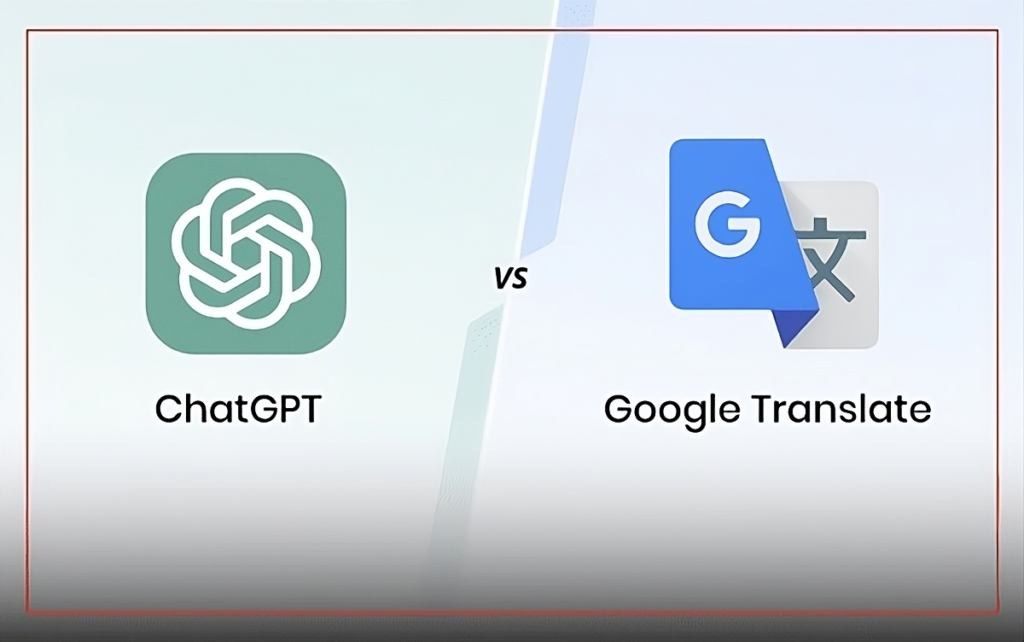Text translation services have broken barriers in accelerating content consumption and communication around the world. With the advent and rapid improvement of natural language models and translation applications, translation is now an easy task. Unsurprisingly then, there’s a constant comparison of the various translation applications out there, the most popular being ChatGPT vs. Google Translate.
However, ever since ChatGPT gained popularity, people have also tested its language translation capabilities, specifically the ChatGPT translation quality. Using ChatGPT for translation has been an interesting application of AI-based language models. Comparing ChatGPT vs. Google Translate for translation, Google Translate excels in direct, word-for-word translation across a vast range of languages, while ChatGPT is better suited for contextual and nuanced translations, especially in complex sentences or idiomatic expressions.
Let’s investigate the nuances of artificial intelligence translators to understand who wins between ChatGPT vs. Google Translate, and how we can leverage ChatGPT for translation to its best capability.
Firstly, What Does a Good Language Translation Look Like?
Well translated text does not just imply word-to-word translation from one language to another. It should also account for the context, lexical semantics (i.e. word relationships) and the intended meaning of phrases. A piece of well-translated text will identify the use of idioms and metaphors that are native to a particular language and accurately convey the meaning of the same in the translated language rather than just providing a literal translation for these phrases.
In other words, text translation should convey the meaning of the entire body of text as a whole.
However, this is not an easy task.
Language translation has its unique challenges, especially when it comes to machine translation. Machine translation is tough because all languages aren’t the same in their approach to constructing sentences.
For instance, in languages such as French, pronouns exhibit gender distinctions, whereas in Japanese, pronouns are mostly left out.
Likewise, in Chinese, distinctions between singular and plural nouns are minimal.
However, in English there are noticeable distinctions between singular and plural words.
Moreover, there’s the matter of context and informal language usage. Machine translation tools struggle to accurately interpret the context of a statement. A statement that holds a particular meaning in one language might convey a different meaning in another. The challenges continue with colloquial expressions that incorporate proverbs, idioms, and linguistic creativity. These aspects can pose difficulties when attempting translation.
Can ChatGPT Translate?
In the fascinating realm of language translation, a trending comparison often arises: ChatGPT vs Google Translate. When it comes to ChatGPT translation, it’s essential to acknowledge its advanced AI-driven approach. ChatGPT for translation utilizes deep learning algorithms, enabling it to understand and translate context more effectively than traditional methods. However, when we look at ChatGPT translate capabilities in isolation, we see a blend of strengths and weaknesses. The ChatGPT translation quality primarily shines in its ability to grasp idiomatic expressions and nuanced language, offering translations that often feel more natural and less mechanical compared to some standard translation tools. But the question, “Is ChatGPT good at translation?” isn’t a straightforward one. While ChatGPT demonstrates proficiency in various linguistic aspects, its effectiveness can vary based on the complexity of the text and the specific languages involved, making it a formidable yet not infallible competitor to Google Translate.
ChatGPT vs. Google Translate: Where does ChatGPT win?
Let’s take an example of a commonly used English idiom “through thick and thin” which means “under all circumstances, irrespective of the difficulty”. You can use it in a sentence by saying – “My friends have been by my side through thick and thin.”. Let’s ask Google Translate to convert this phrase into the Spanish language.
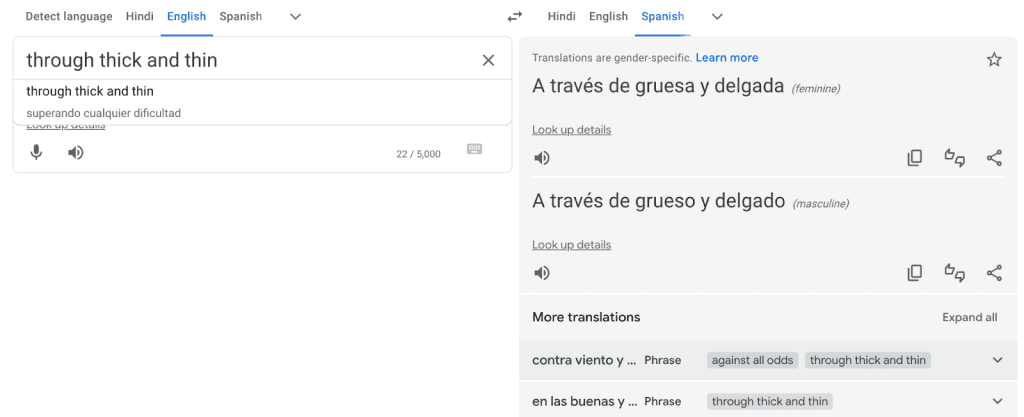
In the above image, we see that Google Translate directly translated every word of the phrase into the corresponding word in Spanish and gave the feminine and masculine words for the adjectives “thick” and “thin”. Google Translate did not really understand the context and the meaning of the phrase while translating it. Let’s now try using ChatGPT for translation of the same phrase.

In the above example, we see that ChatGPT can not only understand the meaning of the original input phrase in English, but also translate it accurately in Spanish. It also allows the user the flexibility to ask for the meaning of the phrase in the same prompt. This is a great example of an artificial intelligence translator understanding natural language well and providing accurate results for machine translation.
Let’s look at another example of using these AI translators to give us the English translation for a common Chinese phrase. This phrase literally translates to “In this hypocritical society, true personality is a rare and precious asset.”
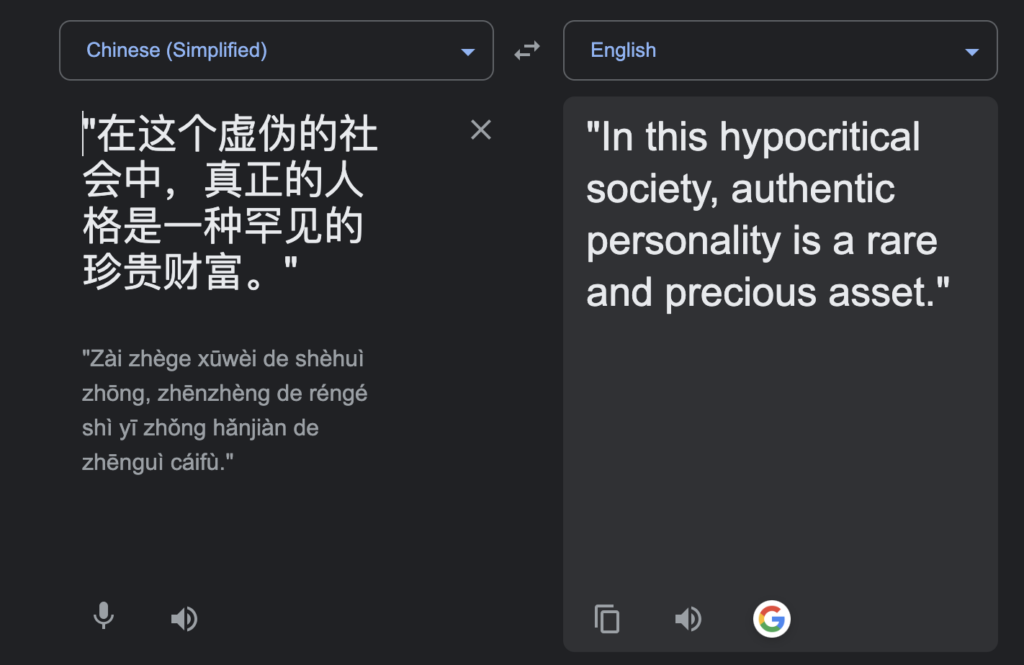
When using ChatGPT for translation of this phrase, the following results were obtained.

Both artificial intelligence translators gave similar results.
Let’s take another example for investigating the ChatGPT vs. Google Translate debate. This time, we consider Creoles, which is the language spoken and used by an ethnic group in the Caribbean. It is a form of Pidgin English i.e. a mixture of English and local languages which enables people who do not share a common language to communicate. This language has words from the English language along with other languages.
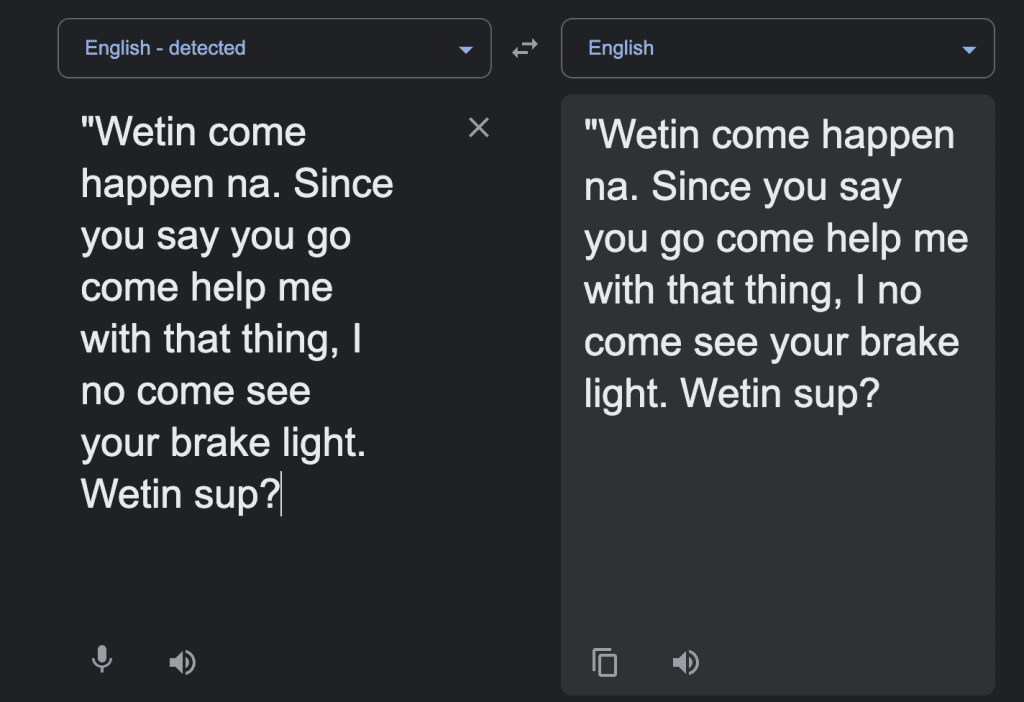
Checking the quality of ChatGPT translation – the AI translator did a good job in understanding the text and translating it accurately. ChatGPT also detected the language accurately and explained the origin of the same, when prompted.
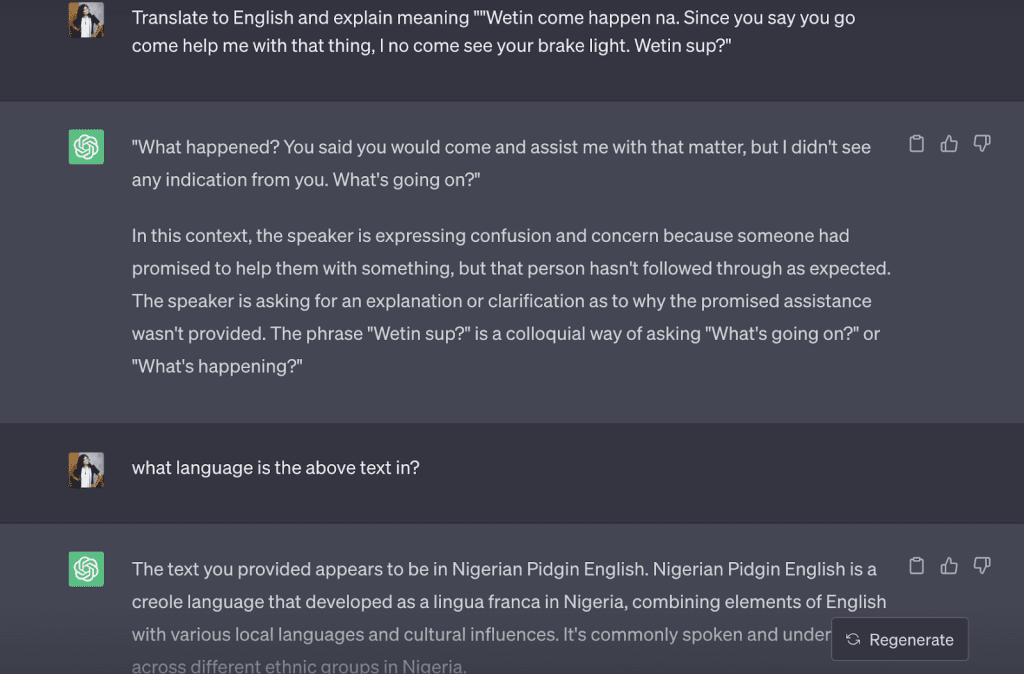
What Contributes to ChatGPT Translation Quality?
These examples show that using ChatGPT for translation not only gives better results in most cases but also provides additional benefits of explaining the phrase or the input sentence. This is because the artificial intelligence translator allows the users to design their prompts according to their needs. Google Translate is a dedicated service for language translation and has limited capabilities.
Let’s elaborate on ChatGPT’s translation abilities:
- ChatGPT is an artificial intelligence translator with natural language capabilities beyond language translation.
- This means that ChatGPT comprehends context better than Google Translate and can produce answers that integrate the provided context.
- This enables it to manage intricate language situations and produce consistent translations, while Google Translate primarily emphasizes isolated sentences or phrases.
This gives ChatGPT translation the advantage in the ChatGPT vs. Google Translate debate in terms of understanding context and the lexical semantics.
The special ingredient that makes ChatGPT unique is RLHF – Reinforcement Learning with Human Feedback.
Also Read: What Is The ChatGPT Code Interpreter?
In this process, the artificial intelligence model gathers information about human inclinations towards model-generated responses, considering aspects like accuracy, lack of harm, usefulness, and so on. By taking human preferences into account, the system can choose responses that are better suited to different cultural contexts, particularly beneficial for those who are not native speakers.
ChatGPT also has this ability to customize the nature of the translated text on the basis of specific word-mappings or domains (for example: medical, legal) that the user can mention in their prompts. For instance, in the below image, we provided certain words that we wanted the translated text to have, to make it sound more professional in the legal jargon.
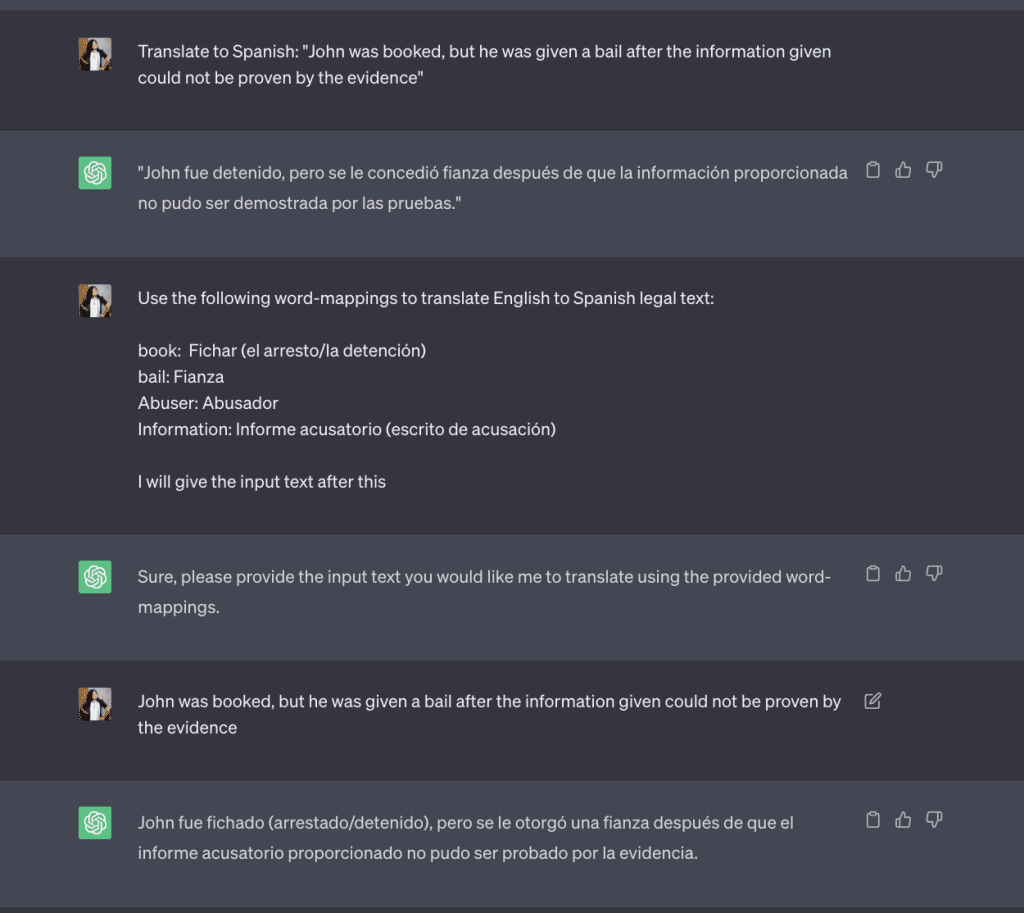
So you can enter custom term lists and translation memories in ChatGPT for this customization. This flexibility is not offered by Google Translate.
Moreover, Google Translate and other conventional machine translation systems cannot account for variations in language based on regions. For example, they don’t distinguish between Canadian and European French, Brazilian and European Portuguese, or Mandarin and Cantonese Chinese. However, ChatGPT is capable of doing this. Here’s an example:
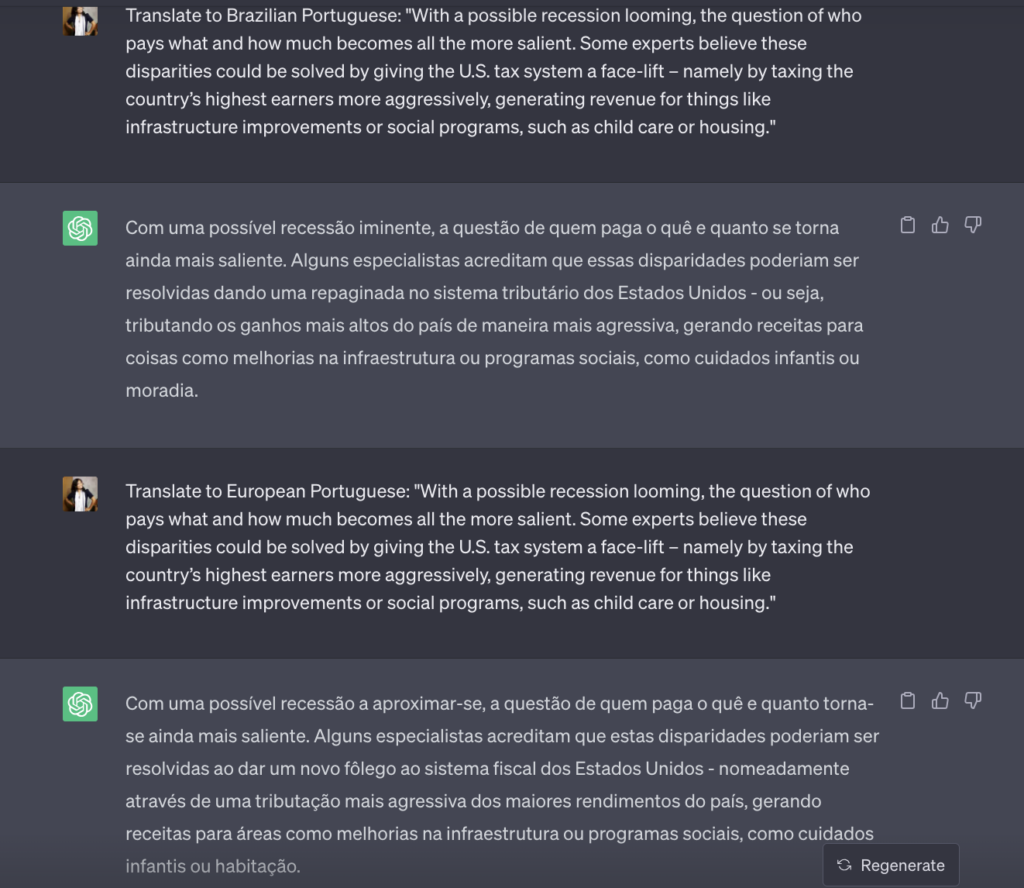
ChatGPT vs. Google Translate: Where does ChatGPT lack?
Despite the impressive ChatGPT translation quality, there are a few caveats in how it operates.
The first and the easiest factor is the ease of access of Google Translate. You don’t need to login to a portal or create a specific account for accessing Google Translate for language translation.
Google Translate provides a specialized user interface and seamlessly connects with other Google services, enhancing its user-friendliness and convenient accessibility. However, to use ChatGPT for translation, you have to create an account. However, this account is free to create and maintain.
Moreover, since ChatGPT has been trained on a huge corpus of historical data, there is a chance of errors and inconsistencies creeping in. It is not a fail-proof tool. Moreover, if there isn’t enough content on the web on a particular language, say the Cambodian Khmer language, the artificial intelligence translator will never be able to learn and to pre-train itself on this language. This would lead to inaccurate or incomplete translations.
Additionally, Google Translate functions as a specialized language model designed specifically for machine translation purposes. Given its specialization, Google Translate proves effective for rapid and uncomplicated translation needs, particularly in cases where utmost precision isn’t the central requirement.
The user-friendly nature of Google Translate, coupled with its seamless integration with various Google services, renders it a practical choice for day-to-day translation tasks.
Also, since it is a simpler machine learning model, it is faster and more computationally efficient to run when you need a framework for machine translation of languages.
ChatGPT vs. Google Translate: Will ChatGPT replace Google Translate?
Our final verdict on ChatGPT vs. Google Translate is that ChatGPT cannot fully replace Google Translate as a machine translation tool, owing to the ease, speed and convenience of the latter. However, it definitely has better performance in terms of understanding context and language nuances which Google Translate lacks. This would require Google Translate to work on its current language model to incorporate these cases and language nuances.
With Google’s current work in developing its large language models, it should improve the performance of its machine translation tool to match, or even surpass the current ChatGPT translation accuracy. Perhaps then the whole ChatGPT vs. Google Translate debate will have different results.


